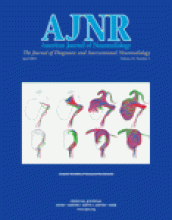Abstract
BACKGROUND AND PURPOSE: Diffusion-weighted (DW) MR imaging is important in evaluating acute stroke, and knowledge of the signal intensity changes associated with acute stroke is valuable. Our purpose was to model the time course of the signal intensity of infarcts and to characterize the apparent diffusion coefficient (ADC) and T2 effects on total signal intensity.
METHODS: Ninety-two patients were included in this prospective cross-sectional study. Signal intensity in infarcts (4 hours to 417 days) and control regions were recorded on DW images (b = 0 and 1000 s/mm2), ADC maps, and ratio images (image with b = 1000 s/mm2 divided by image with b = 0 s/mm2). Cubic spline functions were used for polynomial fitting. The time courses of log signal intensity with log time were modeled. The independent contributions of T2 and ADC to the total signal intensity were retrospectively compared at 0–63 hours, 3–10 days, 11–57 days, and 57 days onward.
RESULTS: Mean signal intensity on DW images was maximal at 40 hours after infarction and normalized at 57 days. At 0–63 hours, the positive effect of ADC on signal intensity was greater than that of T2 (log value,13 ± 0.04 vs 0.11 ± 0.05; P = .04). At days 3–10, the positive T2 effect predominated (0.13 ± 0.08 vs 0.08 ± 0.04; P = .12). At 10–57 days, the positive T2 effect was greater than the negative ADC effect. After day 57, the negative ADC effect predominated.
CONCLUSION: The signal intensity of infarcts on DW images normalizes at 57 days, which is substantially later than previously suggested. T2 (shine-through) effect contributes largely to the total infarct signal intensity.
- Copyright © American Society of Neuroradiology












